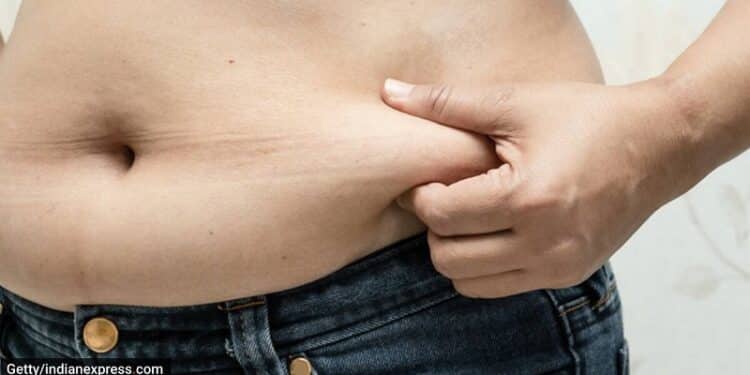Belly fat is more than a nuisance that makes your clothes feel tight; it’s a health concern. It’s seriously harmful. Excessive consumption can increase your risk of certain chronic conditions. Drinking less alcohol, eating more protein, and lifting weights are just a few steps you can take to lose belly fat.
One type of belly fat, visceral fat, is a significant risk factor for type 2 diabetes, heart disease, and other conditions.
Many health organisations use the body mass index (BMI) to classify weight and predict the risk of metabolic diseases.
However, this is misleading, as people with excess belly fat are at an increased risk even if they look thin.
Though losing fat from this area can be difficult, there are several things you can do to reduce excess abdominal fat.
19 practical tips to lose belly fat backed by scientific studies
1. Eat plenty of soluble fibre. Soluble fibre absorbs water and forms a gel that helps slow down food as it passes through your digestive system. Studies show that this type of fibre promotes weight loss by helping you feel full, so you naturally eat less. It may also decrease the number of calories your body absorbs from food.
What’s more, soluble fibre may help fight belly fat.
An observational study of over 1,100 adults found that for every 10-gram increase in soluble fibre intake, belly fat gain decreased by 3.7% over 5 years.
Make an effort to consume high-fibre foods every day. Excellent sources of soluble fibre include:
Flax seeds, shirataki noodles, Brussels sprouts, avocados, legumes, and blackberries
2. Avoid foods that contain trans fats. Trans fats are created by pumping hydrogen into unsaturated fats, such as soybean oil.
They’re found in some types of margarine and spreads and are also often added to packaged foods; however, many food producers have stopped using them.
In observational and animal studies, these fats have been associated with inflammation, heart disease, insulin resistance, and increased abdominal fat.
A 6-year study found that monkeys who consumed a high-trans fat diet gained 33% more abdominal fat than those who consumed a monounsaturated fat diet.
To help reduce belly fat and protect your health, read ingredient labels carefully and avoid products that contain trans fats, which are often listed as partially hydrogenated fats.
3. Don’t drink too much alcohol. Alcohol can have health benefits in small amounts, but it’s seriously harmful if you drink too much.
Research suggests that too much alcohol can also make you lose belly fat.
Observational studies link heavy alcohol consumption to a significantly increased risk of developing central obesity—that is, excess fat storage around the waist.
Cutting back on alcohol may help reduce your waist size. You don’t need to give it up altogether, but limiting the amount you drink daily can help.
One study on alcohol use involved more than 2,000 people.
Results showed those who drank alcohol daily but averaged less than one drink per day had less belly fat than those who drank less frequently but consumed more alcohol on the days they drank.
4. Eat a high-protein diet. Protein is a crucial nutrient for effective weight management.
High protein intake increases the release of the fullness hormone PYY, which in turn decreases appetite and promotes feelings of fullness. Protein also raises your metabolic rate and helps you to retain muscle mass during weight loss.
Numerous observational studies have shown that individuals who consume more protein tend to have less abdominal fat than those who follow a lower-protein diet.
Be sure to include a good protein source at every meal, such as meat, fish, eggs, dairy, whey protein, and beans.
5. Reduce your stress levels. Stress can cause you to gain belly fat by triggering the adrenal glands to produce cortisol, the primary stress hormone.
Research indicates that high cortisol levels can increase appetite and promote abdominal fat storage. Moreover, women with a large waist tend to produce more cortisol in response to stress. Increased cortisol further adds to fat gain around the middle.
To reduce belly fat, engage in pleasurable activities that relieve stress, such as yoga or meditation.
6. Avoid eating a lot of sugary foods. Sugar contains fructose, which, when consumed in excess, has been linked to several chronic diseases. These include heart disease, type 2 diabetes, obesity, and fatty liver disease.
Observational studies show a relationship between high sugar intake and increased abdominal fat. It’s important to realise that more than refined sugar can lead to belly fat gain. Even healthier sugars, such as real honey, should be used sparingly.
7. Do aerobic exercise (cardio). Aerobic exercise (cardio) is an effective way to improve your health and burn calories.
Studies also show that it’s one of the most effective forms of exercise for reducing belly fat. However, results are mixed regarding whether moderate or high-intensity exercise is more beneficial.
In any case, the frequency and duration of your exercise program are more important than its intensity.
One study found that postmenopausal women lost more fat in all areas when they exercised aerobically for 300 minutes per week compared with those who exercised 150 minutes per week.
8. Cut back on carbs — especially refined carbs. Reducing your carb intake can be very beneficial for losing abdominal fat.
Diets with under 50 grams of carbs per day cause belly fat loss in people who are overweight, those at risk for type 2 diabetes, and women with polycystic ovary syndrome (PCOS).
You don’t have to follow a strict low-carb diet. Some research suggests that simply replacing refined carbs with unprocessed starchy carbs may improve metabolic health and reduce belly fat.
In the famous Framingham Heart Study, people who consumed the most whole grains were 17% less likely to have excess abdominal fat than those who consumed diets high in refined grains.
9. Perform resistance training (lift weights). Resistance training, also known as weightlifting or strength training, is crucial for maintaining and building muscle mass.
Based on studies involving people with prediabetes, type 2 diabetes, and fatty liver disease, resistance training may also be beneficial for belly fat loss.
One study involving overweight teenagers found that a combination of strength training and aerobic exercise resulted in the most significant decrease in visceral fat.
If you decide to start lifting weights, getting advice from a certified personal trainer is a good idea.
10. Avoid sugar-sweetened beverages. Sugar-sweetened beverages are loaded with liquid fructose, which can make you gain belly fat.
Studies have shown that consuming sugary drinks can lead to increased fat in the liver. One 10-week study found significant abdominal fat gain in people who consumed high-fructose beverages. Sugary beverages appear to be even worse than high-sugar foods.
Since your brain doesn’t process liquid calories like it does solid ones, you’re likely to consume too many calories later on and store them as fat.
To lose belly fat, it’s best to avoid altogether sugar-sweetened beverages such as soda, punch, sweet tea, and alcoholic mixers containing sugar.
11. Get plenty of restful sleep. Sleep is essential for numerous aspects of your health, including weight management. Studies show that people who don’t get enough sleep tend to gain more weight, which may include belly fat.
A 16-year study involving more than 68,000 women found that those who slept less than 5 hours per night were significantly more likely to gain weight than those who slept 7 hours or more per night.
Sleep apnea, a condition in which breathing stops intermittently during the night, has also been linked to excess visceral fat.
In addition to sleeping at least 7 hours per night, ensure you get sufficient quality sleep.
If you suspect you may have sleep apnea or another sleep disorder, speak to a doctor and get treated.
12. Track your food intake and exercise. Many things can help you lose weight and belly fat, but the key is to consume fewer calories than your body needs for weight maintenance.
Keeping a food diary or using an online food tracker or app can help you monitor your calorie intake. This strategy is beneficial for weight loss.
In addition, food-tracking tools help you monitor your intake of protein, carbohydrates, fibre, and micronutrients. Many also allow you to record your exercise and physical activity.
You can find five free apps/websites to track nutrient and calorie intake on this page.
13. Eat fatty fish every week. Fatty fish are incredibly healthy. They’re rich in high-quality protein and omega-3 fats that protect you from disease.
Some evidence suggests that these omega-3 fats may also help reduce visceral fat.
Studies in adults and children with fatty liver disease show that fish oil supplements can significantly reduce liver and abdominal fat.
Aim to get 2–3 servings of fatty fish per week. Good choices include: salmon, herring, sardines, mackerel
and anchovies.
14. Stop drinking fruit juice. Although fruit juice provides vitamins and minerals, it’s just as high in sugar as soda and other sweetened beverages.
Drinking large amounts may carry the same risk for abdominal fat gain. An 8-ounce (240-mL) serving of unsweetened apple juice contains 24 grams of sugar, half of which is fructose (58).
To help reduce excess belly fat, replace fruit juice with water, unsweetened iced tea, or sparkling water, and add a wedge of lemon or lime.
15. Add apple cider vinegar to your diet. Drinking apple cider vinegar has impressive health benefits, including lowering blood sugar levels.
It contains acetic acid, which has been shown to reduce abdominal fat storage in several animal studies.
In a 12-week controlled study of men diagnosed with obesity, those who took 1 tablespoon (15 mL) of apple cider vinegar per day lost half an inch (1.4 cm) from their waists.
Taking 1–2 tablespoons (15–30 mL) of apple cider vinegar daily is safe for most people and may lead to modest fat loss.
However, be sure to dilute it with water, as undiluted vinegar can erode the enamel on your teeth.
16. Eat probiotic foods or take a probiotic supplement. Probiotics are bacteria found in some foods and supplements. They offer numerous health benefits, including the improvement of gut health and enhancement of immune function.
Researchers have discovered that various types of bacteria play a role in regulating weight, and maintaining the right balance can aid in weight loss, including the reduction of belly fat.
Those shown to reduce belly fat include members of the Lactobacillus family, such as Lactobacillus fermentum, Lactobacillus amylovorus and especially Lactobacillus gasseri.
Probiotic supplements typically contain several types of bacteria, so purchase one that provides one or more of these bacterial strains.
17. Try intermittent fasting. Intermittent fasting has gained significant popularity as a weight loss method.
It’s an eating pattern that cycles between eating and fasting periods.
One popular method involves fasting for 24 hours once or twice a week. Another consists of fasting for 16 hours every day and eating all your food within the remaining 8 hours.
In a review of intermittent and alternate-day fasting studies, people experienced a 4–7% decrease in abdominal fat within 6–24 weeks (70).
There’s some evidence that intermittent fasting, generally, may not be as beneficial for women as for men.
Although specific modified intermittent fasting methods appear to be better options, stop fasting immediately if you experience any negative effects.
18. Drink green tea. Green tea is an exceptionally healthy beverage.
It contains caffeine and the antioxidant epigallocatechin gallate (EGCG), which appear to boost metabolism.
EGCG is a catechin, which several studies suggest may help you lose belly fat. The effect may be strengthened when green tea consumption is combined with exercise.
19. Change your lifestyle and combine different methods. Completing just one of the items on this list won’t have a significant impact.
To achieve good results, you need to combine effective methods. Interestingly, many of these methods are generally associated with healthy eating and an overall healthy lifestyle.
Therefore, changing your lifestyle for the long term is key to losing and maintaining a slim waistline.
When you have healthy habits and eat real food, fat loss tends to follow as a natural side effect.












